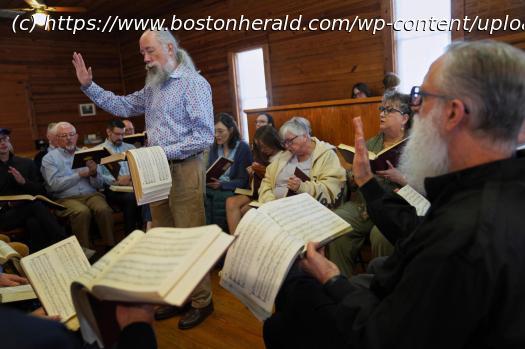It’s no accident “The Sacred Harp” is still in use today.
Singers at Holly Springs Primitive Baptist Church in West Georgia treat their red hymnals like extensions of themselves, never straying far from their copies of “The Sacred Harp” and its music notes shaped like triangles, ovals, squares and diamonds.
In four-part harmony, they sing together for hours, carrying on a more than 180-year-old American folk tradition that is as much about the community as it is the music.
It’s no accident “The Sacred Harp” is still in use today, and a new edition — the first in 34 years — is on its way.
Since the Christian songbook’s pre-Civil War publication, groups of Sacred Harp singers have periodically worked together to revise it, preserving its history and breathing new life into it. It’s a renewal, not a reprint, said David Ivey, a lifelong singer and chair of the Sacred Harp Publishing Company’s revision and music committee.
“That’s credited for keeping our book vibrant and alive,” said Ivey.
First published in 1844 by West Georgia editors and compilers Benjamin F. White and Elisha J. King, revisions of the shape-note hymnal make space for songs by living composers, said Jesse P. Karlsberg, a committee member and expert on the tradition.
“This is a book that was published before my great-grandparents were born and I think people will be singing from it long after I’m dead,” said Karlsberg, who met his wife through the a cappella group practice, which is central to his academic career. It’s also his spiritual community.
“It’s changed my life to become a Sacred Harp singer.”Cuts, additions and other weighty decision making
The nine-member revision committee feels tremendous responsibility, said Ivey, who also worked on the most recent 1991 edition.
Sacred Harp singers are not historical reenactors, he said. They use their hymnals week after week. Some treat them like scrapbooks or family Bibles, tucking mementos between pages, taking notes in the margins and passing them down. Memories and emotions get attached to specific songs, and favorites in life can become memorials in death.
“The book is precious to people,” said Ivey, on a March afternoon surrounded by songbooks and related materials at the nonprofit publishing company’s museum in Carrollton, Georgia.
Sacred Harp singing is a remarkably well-documented tradition. The small, unassuming museum — about 50 miles west of Atlanta near the Alabama state line — stewards a trove of recordings and meeting minutes of singing events.
The upcoming edition is years in the making. The revision, authorized by the publishing company’s board of directors in October 2018, was delayed by the COVID-19 pandemic. It now will be released in September at the annual convention of the United Sacred Harp Musical Association in Atlanta.
Ivey hopes singers fall in love with it, though he knows there is nervousness in the Sacred Harp community.
Домой
United States
USA — Events It’s not a reprint. Why Sacred Harp singers are revamping an iconic...






